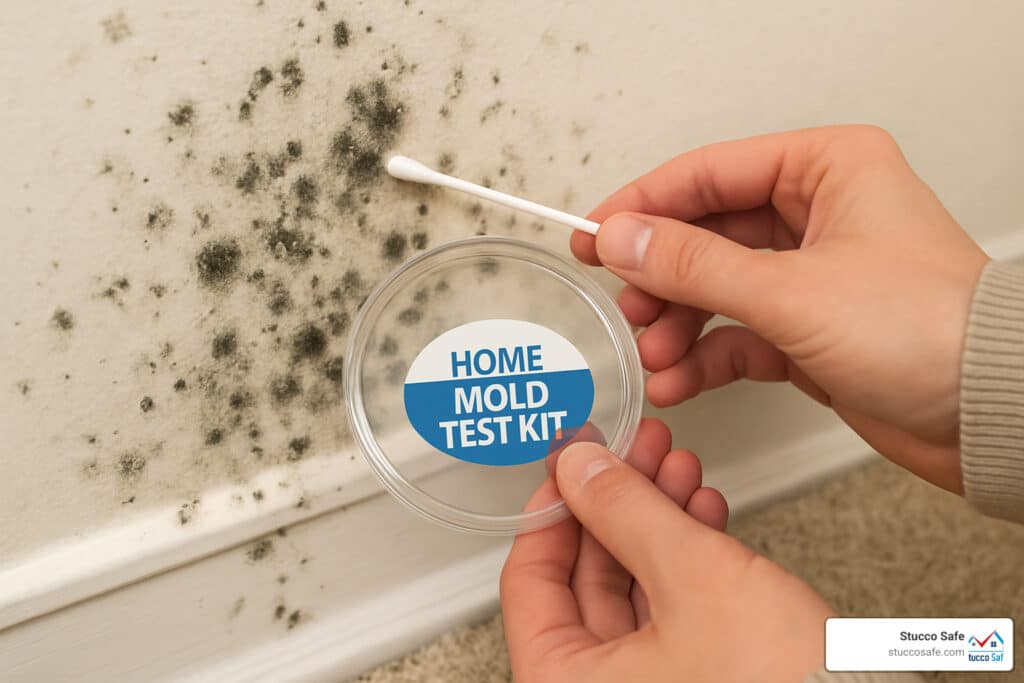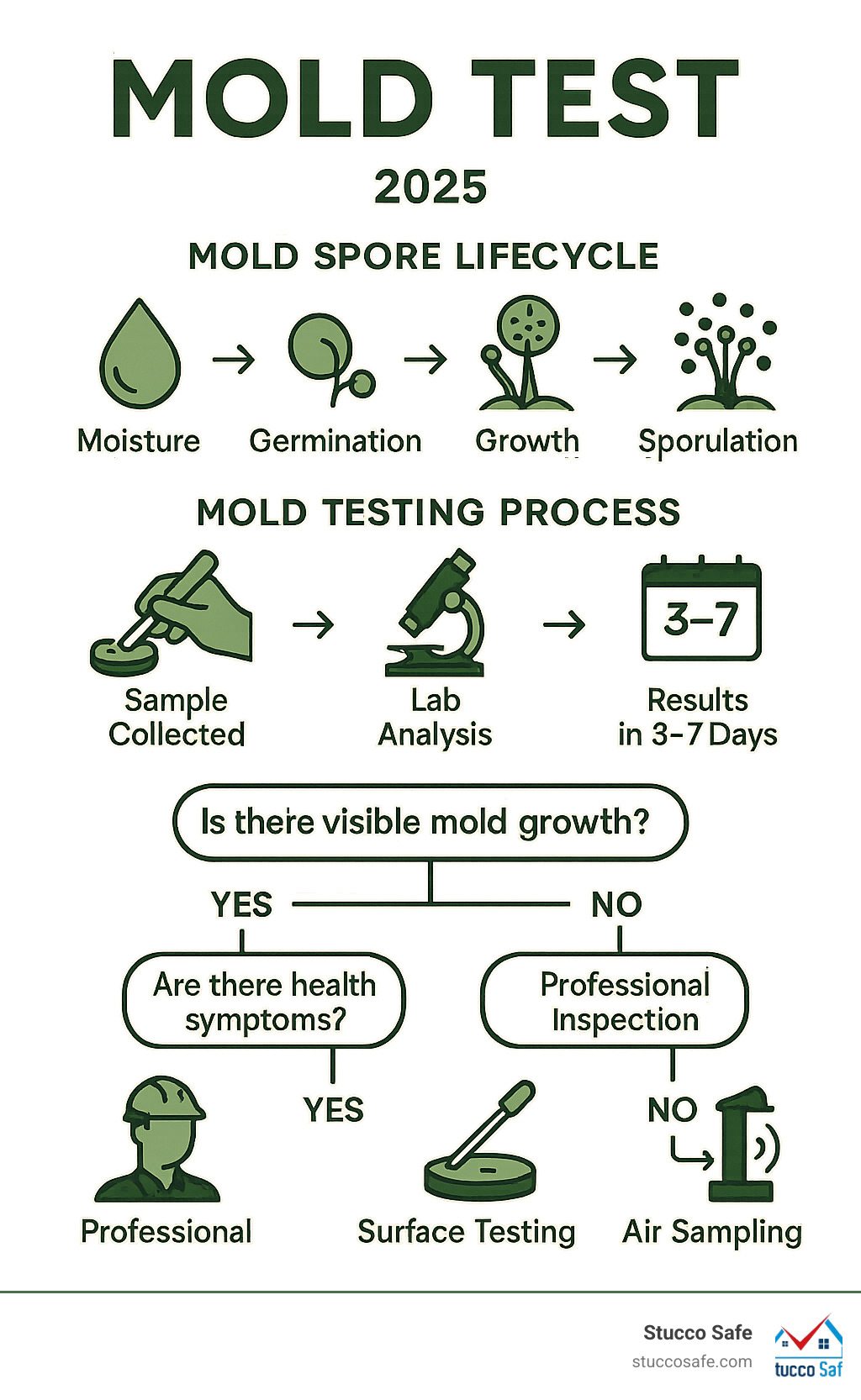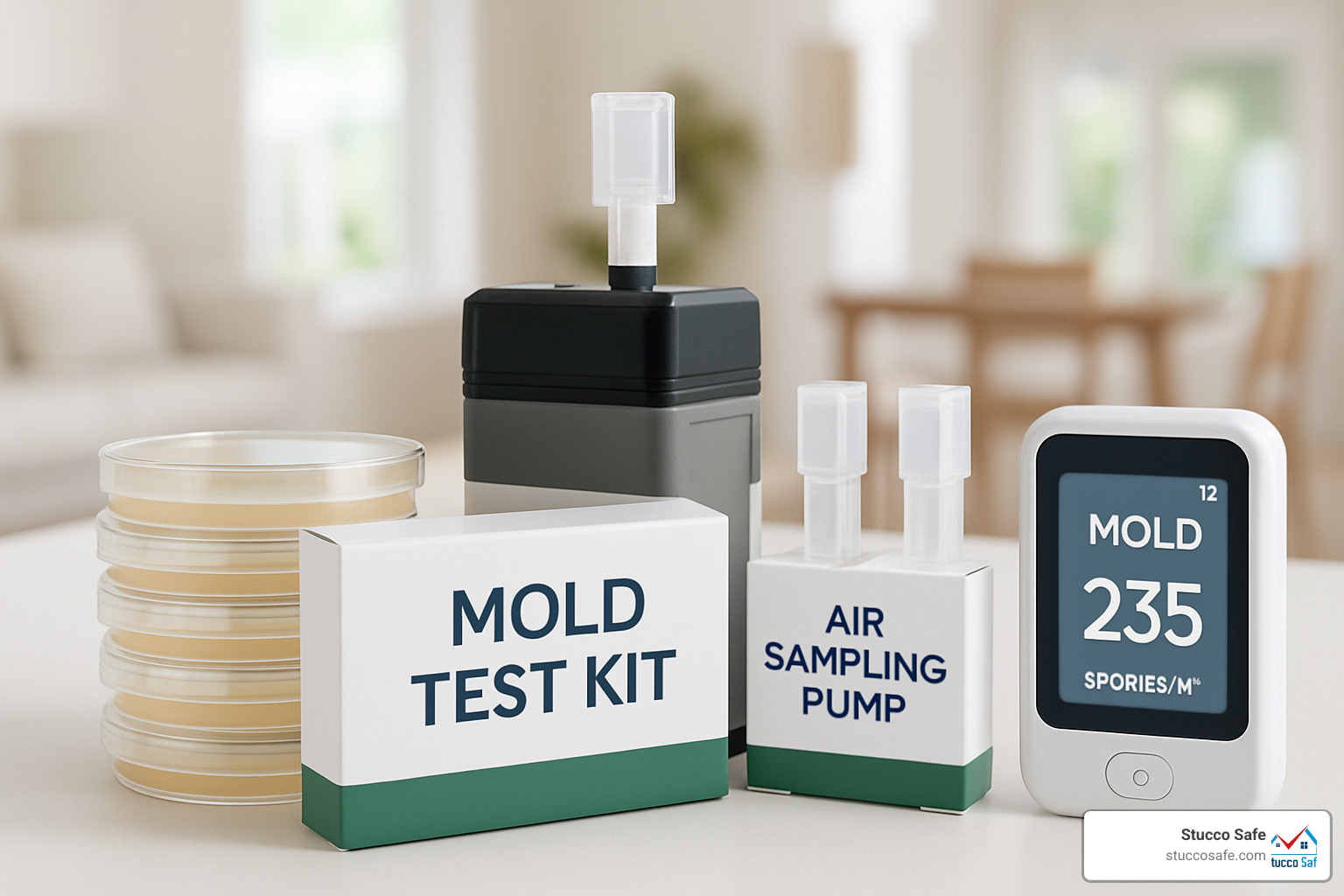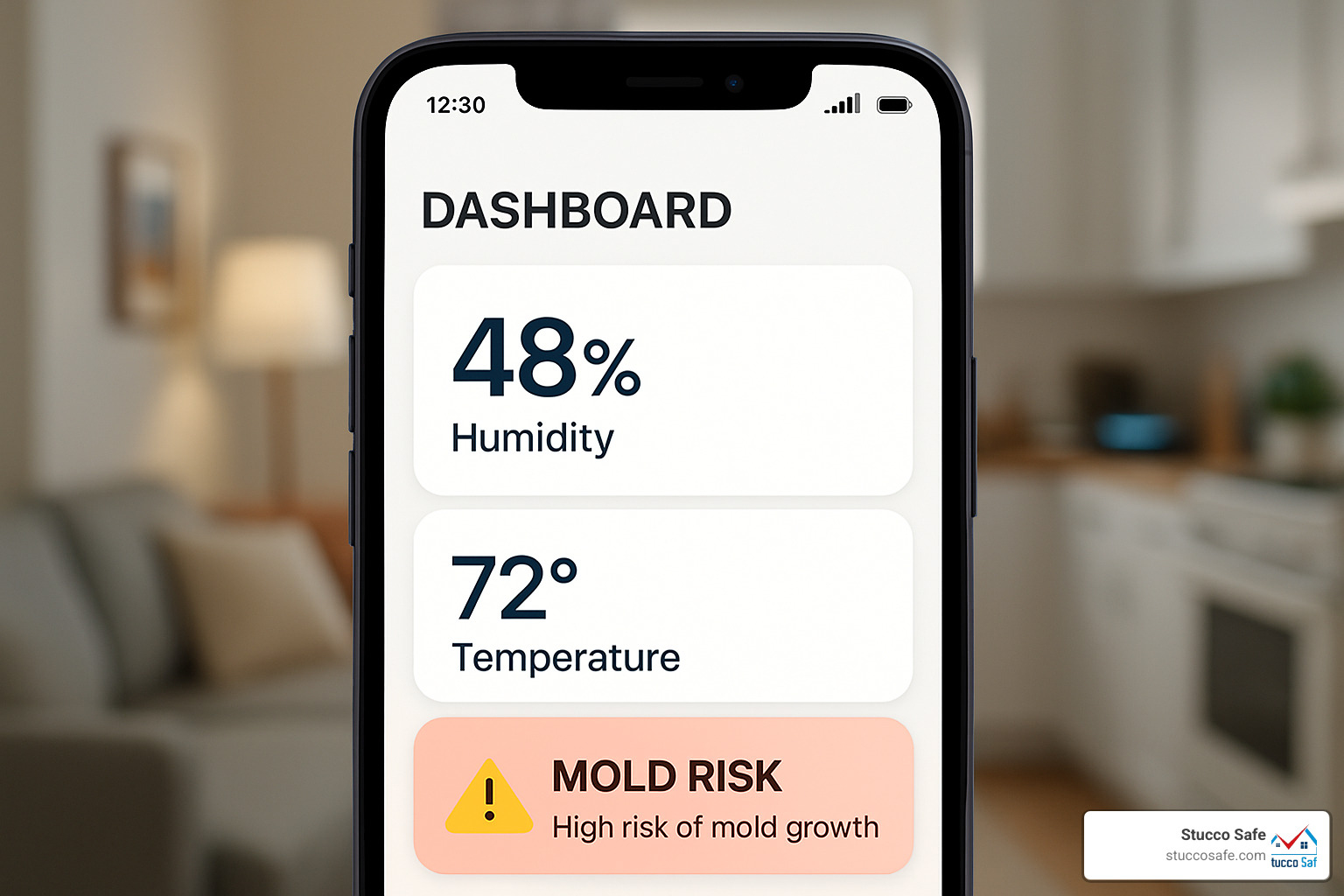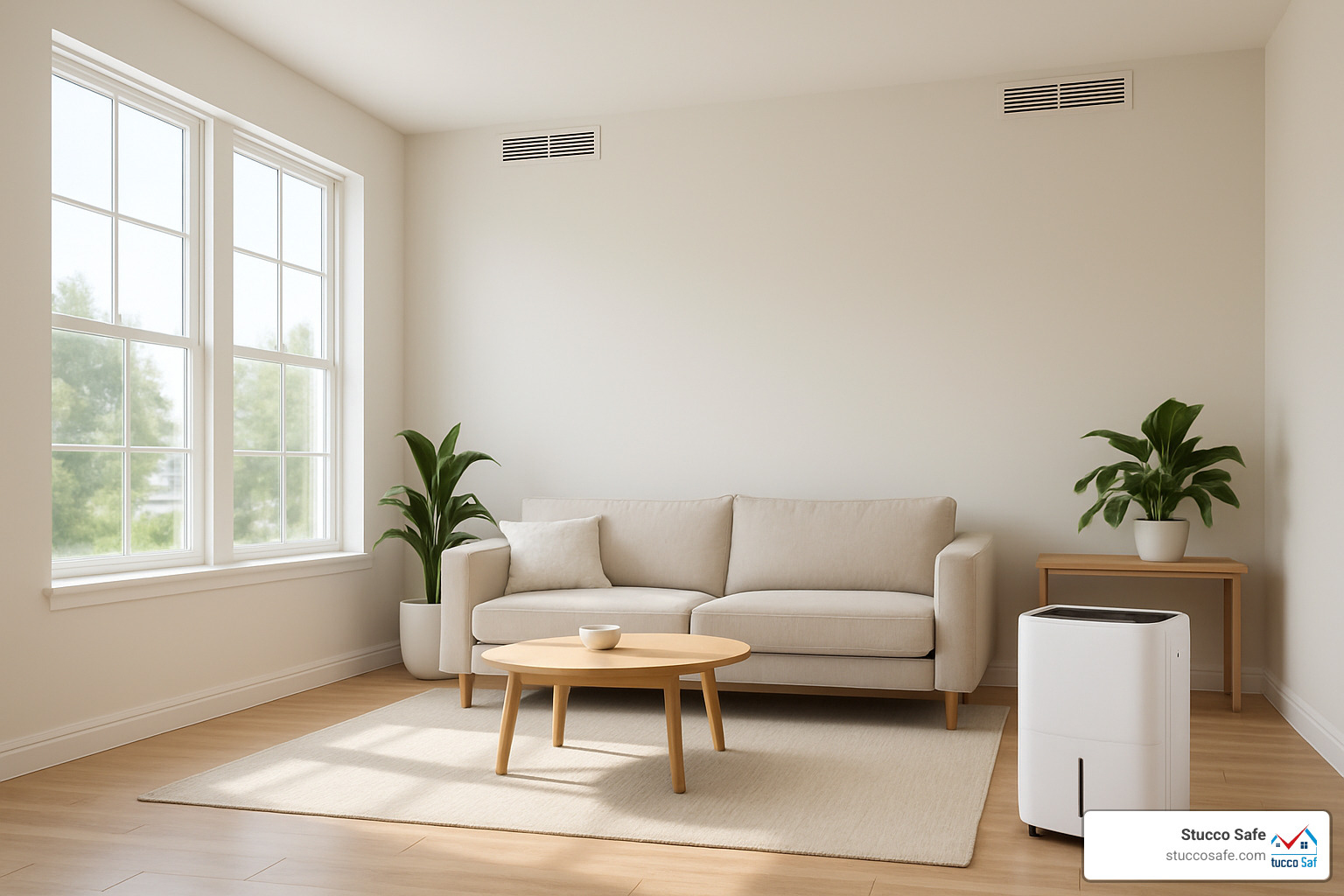Mold Test: 5 Powerful Kits for Best Home Protection 2024
Why Indoor Air Quality Testing is Critical for Your Home
A mold test can reveal hidden spore contamination in your home that puts your family’s health at risk and threatens your property value. Here’s what you need to know about the best testing options:
Top Mold Test Kit Types:
– Air Sampling Kits – Use pumps to capture airborne spores ($90-150)
– Surface Test Kits – Tape-lift or swab visible growth ($35-75)
– Petri Dish Kits – Passive air collection plates ($10-25)
– ERMI Dust Tests – DNA analysis of settled spores ($150-300)
– Smart Monitors – Track humidity and conditions ($200-350)
Mold spores are found everywhere – both indoors and outdoors. The problem starts when indoor levels exceed outdoor baselines, often due to moisture from leaks, flooding, or poor ventilation. According to the CDC, there’s no acceptable amount of any type of mold indoors, which is why removal should happen as soon as mold is spotted.
Hidden mold behind walls, in HVAC systems, or under flooring can trigger respiratory issues, allergies, and asthma – especially in children and sensitive individuals. For homeowners planning to sell, unfinded mold problems can derail transactions and cost thousands in emergency remediation.
At-home mold test kits bridge the gap between expensive professional inspections and doing nothing. They use the same sampling methods as industrial hygienists but cost a fraction of the price. Most kits provide results within 48-96 hours for visual tests, while lab analysis typically takes 3-7 business days.
I’m Gabe Kesslick, and I’ve been investigating moisture intrusion and mold issues since 2001 as a certified building envelope inspector. Through hundreds of mold test investigations, I’ve seen how early detection saves homeowners from costly structural damage and health problems.
Simple mold test word guide:
– home inspection basement moisture
– home mold inspection
– how to detect mold in your home
What You’ll Learn
In this comprehensive guide, we’ll walk you through everything you need to know about choosing and using mold test kits for your home. Whether you’re dealing with a musty basement, investigating water damage, or simply want peace of mind about your indoor air quality, we’ll help you select the right testing method for your specific situation.
You’ll find how different kit types work, what results mean, when DIY testing makes sense versus calling a professional, and how to interpret findings to protect your family’s health.
Why Mold Testing Matters: Health, Property & Peace of Mind
Mold exposure affects millions of families every year with symptoms that can sneak up on you – respiratory issues, persistent nasal congestion, irritated eyes, unexplained skin rashes, body aches, and recurring fevers that just won’t go away.
Mold often grows silently behind walls, under flooring, or in HVAC systems for months before you notice anything wrong. By then, your family has been breathing contaminated air without realizing it.
Children, elderly family members, and anyone with compromised immune systems face the greatest risk from mold exposure. If someone in your household has allergies or asthma, mold can turn their condition from manageable to miserable. Scientific research on indoor mold and asthma confirms there’s a direct connection between mold exposure and worsening respiratory health.
The financial impact hits just as hard as the health effects. Mold literally eats your house from the inside out, feeding on wood framing, drywall, insulation, and other organic materials. We’ve walked through homes where hidden mold growth led to $30,000+ in emergency remediation costs – damage that could have been prevented with a simple mold test costing under $100.
Moisture sources are everywhere in modern homes. A small plumbing leak behind the bathroom wall, a roof leak that only shows up during heavy storms, steam from cooking and showering, or even an over-enthusiastic humidifier can create perfect growing conditions. Mold needs just 24-48 hours of moisture to establish itself and start spreading.
The warning signs aren’t always obvious. That musty odor in the basement might not be “just an old house smell.” Water stains on ceilings could indicate ongoing moisture problems. If your family experiences unexplained health symptoms that improve when you’re away from home, it’s worth investigating further.
A mold test gives you the facts you need to protect both your family’s health and your property investment. Early detection means smaller problems, lower costs, and peace of mind knowing your indoor air quality is safe.
For more detailed information about identifying potential mold issues in your home, check out our guide on how to check for mold in your house.
Choosing the Right Mold Test for Your Home
Finding the right mold test for your situation doesn’t have to be overwhelming. Think of it like choosing the right tool for a job – each testing method has its sweet spot where it really shines.
Air sampling is your go-to method when you suspect hidden mold but can’t see it. These kits use small pumps to pull air through special spore trap cassettes, capturing airborne mold spores that get sent to a lab for analysis. Air sampling can detect mold hiding behind walls, in HVAC systems, or other sneaky spots. You’ll need at least two samples though – one from inside your home and one from outdoors – to create a proper comparison baseline.
When you can actually see suspicious growth on surfaces, surface sampling becomes your best friend. This method involves either swabbing the area or using special tape to lift samples directly from the suspected mold. It’s particularly handy after you’ve cleaned up a mold problem and want to verify that your efforts were successful.
Bulk sampling takes things a step further by collecting actual pieces of contaminated materials like insulation, drywall, or carpet. While more invasive, this approach provides rock-solid identification of mold species and contamination levels in your building materials.
For the most comprehensive picture of your home’s mold situation, ERMI dust testing analyzes settled dust for DNA from 36 different mold species. Think of it as a historical record of your home’s mold exposure over time. The downside? It requires lab analysis and costs more than other options, but the detailed species breakdown can be invaluable for serious contamination issues.
Smart monitoring systems take a prevention-first approach by tracking humidity, temperature, and volatile organic compounds (VOCs) that create perfect conditions for mold growth. While they don’t directly test for mold, these devices act like early warning systems, alerting you before problems develop.
Accuracy varies quite a bit among different mold test options. Professional-grade air sampling kits that use the same spore trap methods as industrial hygienists deliver highly accurate results when you follow the instructions carefully.
For the most reliable results, stick with kits that send samples to laboratories accredited by the American Industrial Hygiene Association (AIHA). These labs follow strict analytical standards and provide detailed reports with actual spore counts and species identification.
| Test Type | Best For | Accuracy | Cost Range | Time to Results |
|---|---|---|---|---|
| Air Sampling | Hidden mold detection | High | $90-150 | 3-7 days |
| Surface Swab | Visible growth ID | High | $35-75 | 3-7 days |
| Petri Dish | Quick screening | Moderate | $10-25 | 48-96 hours |
| ERMI Dust | Comprehensive analysis | Very High | $150-300 | 7-14 days |
| Smart Monitor | Prevention | N/A | $200-350 | Real-time |
For more detailed guidance on testing methods, check out our comprehensive guide on how to test for mold. The EPA also provides excellent information on mold sampling methods and when testing makes the most sense.
Budget vs. Accuracy: Key Buying Factors
Most of us want the most accurate mold test results without breaking the bank. The good news is you can find a sweet spot between cost and reliability if you know what to look for.
Basic petri dish kits represent the budget-friendly option at $10-25. They give you quick visual results within 48-96 hours, which is great for peace of mind. However, they can’t tell you exactly what type of mold you’re dealing with or provide precise contamination levels.
Mid-range surface swab kits ($35-75) offer excellent value by combining DIY convenience with professional lab analysis. Most include laboratory fees in the purchase price, though some tack on additional charges ranging from $24-40 per sample.
High-end air sampling kits ($90-150) deliver the most accurate results but require more careful sample collection. They use identical methods to what professional inspectors use, making them ideal when you suspect hidden mold sources but can’t pinpoint the location.
Consider how quickly you need results when making your choice. Visual petri dish tests show growth within 48-96 hours, while laboratory analysis typically takes 3-7 business days after the lab receives your samples.
When to Skip the Kit and Call a Pro
Sometimes DIY mold test kits just aren’t the right tool for the job. If you can already see visible mold colonies growing on surfaces, skip the testing phase entirely and move straight to remediation. As the EPA puts it, visible mold makes sampling unnecessary since you already know you have a problem that needs fixing.
Professional assessment becomes essential when dealing with chronic water leaks, extensive suspected contamination, or homes with vulnerable occupants like infants, elderly family members, or anyone with compromised immune systems.
Legal or insurance situations typically require professional documentation, as DIY test results may not carry the same weight as certified professional assessments. If you’re buying or selling a home, professional inspection provides comprehensive documentation and liability protection.
We strongly recommend calling professionals when your mold test results show liftd mold levels or when family members continue experiencing health symptoms despite your remediation efforts.
For more information about professional mold inspection services, visit our home mold inspection page.
Best Mold Test Kits of 2024: Our Top Picks
After hands-on trials in dozens of homes, these five DIY options proved the most reliable, user-friendly, and cost-effective.
1. Air Pump Mold Test Kit (Air Sampling)
The go-to choice when you suspect hidden growth. A battery pump pulls air through Air-O-Cell® spore traps, exactly what pros use. You’ll collect at least one outdoor control and one indoor sample, then mail the cassettes to an AIHA-accredited lab. Reports compare indoor vs. outdoor counts and highlight any problem species.
• Accuracy: Very high
• Best for: Whole-home screening when no mold is visible
• Price: About $120 for three cassettes and lab fees
2. Tape-Lift Mold Test Kit (Surface Sampling)
Perfect for confirming whether that blotch on bathroom tile is mold and, if so, which kind. Clear tape lifts spores from smooth surfaces and heads to the lab for species ID—indispensable for post-remediation verification.
• Accuracy: High
• Best for: Visible spots, clearance testing
• Price: $40–$60 per sample (lab included)
3. Petri Dish Settling Plate Kit (Passive Air)
Costing little more than a pizza, these agar plates sit out for an hour or two and then incubate 48–96 h. You’ll get a quick visual sense of spore activity, useful for comparing rooms or tracking trends over time. They’re a screen, not a diagnosis.
• Accuracy: Moderate
• Best for: Budget screening, before/after humidity fixes
• Price: $10–$25 for three plates
4. Dust ERMI Mail-In Pack (Whole-Home Snapshot)
DNA analysis of settled dust reveals a home’s mold history, living or dead. A simple vacuum attachment collects the sample; the report ranks your home against national databases of water-damaged and normal houses.
• Accuracy: Very high, species-specific
• Best for: Water-damage history, unexplained health issues
• Price: $150–$300
5. Smart Monitor Kit (Condition Tracking)
These Wi-Fi sensors watch humidity, temperature, and VOCs around the clock and ping your phone before conditions hit the mold danger zone. They don’t test spores, but prevention usually beats cleanup.
• Accuracy: N/A (condition monitoring)
• Best for: Ongoing prevention in basements, bathrooms, attics
• Price: $200–$350
Interpreting Results & Next Steps
Lab reports look intimidating, but the core idea is simple: indoor spore counts should be similar to or lower than outdoor levels. When results spike indoors—or when you see red or orange flags on the lab’s traffic-light chart—you have an indoor source to tackle.
Surface swabs tell you which species are present. Stachybotrys or Chaetomium, for example, often point to chronic moisture behind walls and require prompt professional cleanup.
ERMI scores compare your dust sample with national data; the higher the number, the more your home resembles water-damaged buildings.
Regardless of the test type, follow this order of operations:
- Eliminate the moisture source: repair leaks, improve ventilation, run dehumidifiers (< 60 % RH).
- Remove or clean contaminated materials using proper PPE (N95, gloves, eye protection).
- Dry the area completely—mold can restart in 24–48 h if dampness returns.
- Retest (air or surface) 1–2 weeks later to confirm success.
If mold covers more than about 10 sq ft, keeps coming back, or occupants remain symptomatic, skip DIY fixes and call certified pros. Inspection in the Philadelphia–Delaware–NJ region generally runs $300–$800; full remediation ranges widely but is far cheaper than letting structural damage spread.
Frequently Asked Questions about Home Mold Testing
How accurate are at-home kits vs. professional sampling?
When you follow instructions—especially for air sampling kits analyzed by AIHA-accredited labs—DIY accuracy can mirror professional results. The main gap is in experience: inspectors know where and when to sample and can diagnose hidden moisture problems while they’re onsite.
Do I need an outdoor control sample every time?
For air tests, yes. Outdoor spores form the baseline; without that number, indoor counts are meaningless. Surface and ERMI tests do not require an outdoor sample.
How long should I wait to retest after remediation?
Give the area 7–14 days to settle and dry out, then collect new air or surface samples. Immediate testing often shows liftd spores just from the disturbance of cleanup.
Conclusion
Taking control of your home’s air quality doesn’t have to be overwhelming or expensive. The right mold test kit gives you the power to detect problems early, when they’re still manageable and won’t break the bank to fix.
Whether you choose air sampling kits for their professional-grade accuracy, surface sampling to identify that suspicious growth in your bathroom, or petri dish kits for budget-friendly peace of mind, you’re taking a smart step toward protecting your family’s health. Each testing method has its place, and now you know exactly when to use which one.
Testing is really just the beginning of the story. The most expensive mold test in the world won’t help if you don’t address the moisture problem that’s feeding the mold in the first place. Fix those leaks, control that humidity, and improve your ventilation – your future self will thank you when you’re not dealing with a major remediation project.
Regular testing makes sense, especially in those trouble spots we all have – the basement that gets a little too humid in summer, the bathroom with the exhaust fan that sounds like a freight train, or that corner where the roof leaked last winter. Catching problems early is always cheaper than waiting until they become obvious.
There’s no shame in calling for professional help when things get complicated. If you’re seeing widespread visible mold, dealing with chronic water problems, or just can’t shake those unexplained health symptoms, it’s time to bring in the experts. Sometimes the peace of mind alone is worth the investment.
At Stucco Safe, we’ve spent over two decades helping homeowners throughout Southeastern Pennsylvania, New Jersey, and Delaware understand the connection between moisture intrusion and mold problems. Our forensic testing methods and certified inspectors see beyond just the surface issues to identify the root causes that lead to mold growth in the first place.
Whether you’re dealing with stucco moisture infiltration, mysterious basement humidity, or suspected mold contamination, we’re here to provide the professional expertise that complements your DIY efforts. For comprehensive moisture and mold inspection services, visit our mold testing services page to learn how our professional assessment can give you complete confidence in your home’s safety.
Your family deserves clean, healthy air, and your home deserves protection from costly damage. Start with the mold test kit that fits your situation and budget, but don’t stop there. Create a plan for ongoing moisture control and regular monitoring. Early detection and prevention will always beat dealing with established mold problems – both for your wallet and your peace of mind.

